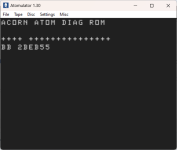Gary C
Veteran Member
Time to get the Acorn Atom on the road
New key donated (thank you every so much !) so keyboard stripped down to find a second key stem snapped along with the missing key.
Also looking at the (already snapped) keystem on the missing key, it doesn't match the others. It fits but is looser and once of the coils of the Sabre Coil switch is not round and sticking in the housing.
So managed to get the faulty coil contact to sit in the depressed position so that the second can swing and make contact. Printed a connector and glued that in place and now have stems on all keys ready for refitting.
But first power up.
Transformer giving out 9v, yay, then 0V, boo now 12V. Turning the transformer upside down and it gives out 12v, turn it right way up, nothing. Annoyingly the case is riveted shut requiring careful snipping out (cant drill, they just spin). Need to find replacements
Transformer exposed and failed solder joint on a 'thingy' located. Not sure what it is. Silver tube with a black cone end
New key donated (thank you every so much !) so keyboard stripped down to find a second key stem snapped along with the missing key.
Also looking at the (already snapped) keystem on the missing key, it doesn't match the others. It fits but is looser and once of the coils of the Sabre Coil switch is not round and sticking in the housing.
So managed to get the faulty coil contact to sit in the depressed position so that the second can swing and make contact. Printed a connector and glued that in place and now have stems on all keys ready for refitting.
But first power up.
Transformer giving out 9v, yay, then 0V, boo now 12V. Turning the transformer upside down and it gives out 12v, turn it right way up, nothing. Annoyingly the case is riveted shut requiring careful snipping out (cant drill, they just spin). Need to find replacements
Transformer exposed and failed solder joint on a 'thingy' located. Not sure what it is. Silver tube with a black cone end

